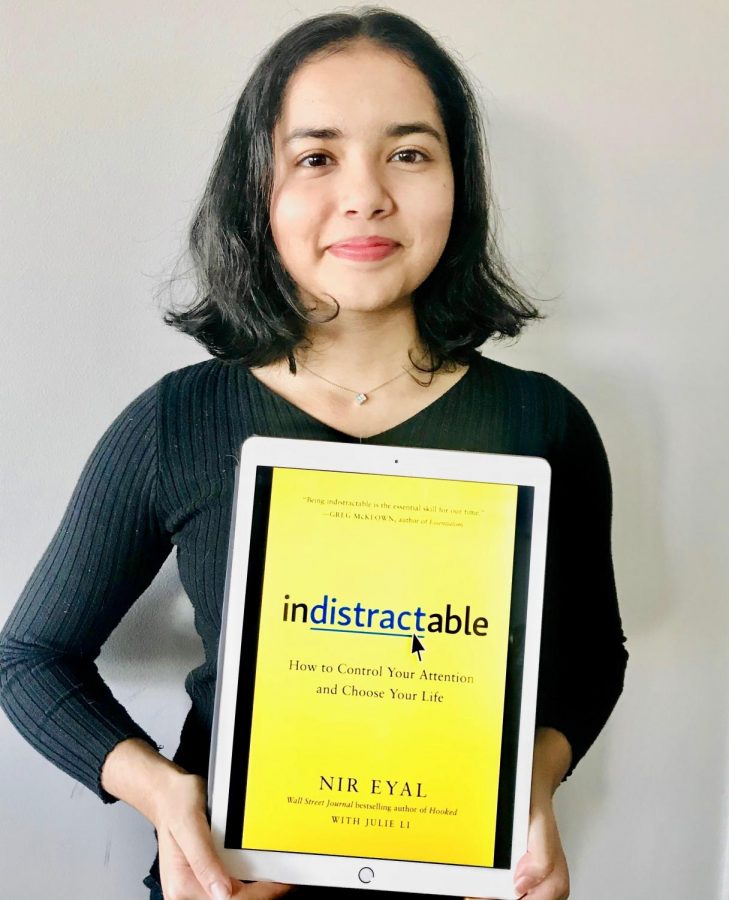Become ‘Indistractable’: Distraction-proof your mind
Sonya Kulkarni uses her iPad to research, download and read books. Published in 2019, the book, “Indistractable: How to Control Your Attention and Choose Your Life” is a National Bestseller.
Technology is killing our generation’s productivity. If you’re on your phone, you won’t get anything done.
At least, that’s what we were led to believe.
International best-selling author, former Stanford lecturer and serial entrepreneur Nir Eyal released Hooked: How to Build Habit-Forming Products in late 2014, and it quickly rose through the bestseller ranks. The book, which soon became a toolkit for tech giants in Silicon Valley, unveiled the best techniques to lure users without the need for exorbitant or excessive advertising.
In his other book published in 2019, “Indistractable” Eyal writes for a different audience: the technology users. He pinpoints distraction-centric technology’s Achilles’ heel and exposes the hidden psychology employed by tech giants to suck our time away on our favorite apps. Eyal explains that the problem is not as simple as swearing off our devices. Abstinence is impractical and often makes us want more.
In fact, smartphone ownership has become a nearly ubiquitous element of teen life: 95 percent of teens now report they have access to a smartphone, and 45 percent of teens say they are online on a near-constant basis.
“Indistractable” imparts the message that in order for humans to coexist happily with technology and not be controlled by it, we need to understand exactly how it works and develop foolproof strategies for combating its overuse.
Eyal overturns conventional wisdom and reveals the secret behind finally “doing what you say you will do” (as Eyal says) with a five-step, research-backed model.
The problem:
Often, when trying to rid ourselves of distraction, we focus on external triggers: the “pings” and “dings” that lead ourselves towards distraction. What we don’t commonly focus on, an actual common source of distraction, are internal triggers. These are the uncomfortable emotional states that we seek to escape, such as loneliness, uncertainty and boredom.
The solution:
- Plan your day (perhaps not with a to-do list):
If you don’t plan your day, someone will plan it for you, whether it’s a distracting classmate or social media. Though to-do lists work for many people, writing items down on an ever-expanding list will not ensure that they will be magically completed. The best place to start is not with the output (what you want to get done every day), but, rather, with the input (how much time you are willing to devote to individual tasks).
- Schedule and block out “You time”:
Distraction has many consequences. In fact, we find that when someone is interrupted during a task, it can take up to 20 minutes for them to refocus on what they were originally doing. If you schedule time for yourself to relax by using distracting-inducing apps and devices, you are less likely to feel nagging internal triggers.
- “Surf” the urge:
In a smoking cessation study, researchers found that when they taught smokers how to notice the sensation of the “pull” they felt towards smoking and be mindful of these experiences, they became far more likely to stop smoking. By “surfing” the urge, we notice what feelings are leading us to distraction, allow the sensation to crest and then subside.
- Be aware of liminal moments and use “time boxing”:
Liminal moments are periods of time when we are transitioning from one task to another. For example, we may take this break time to check our favorite social media app and instead of moving on to the next task, we continue to check the app and it turns into a distraction. Minimize liminal moments by blocking your time into different sections (Eyal refers to this method as “time boxing”).
- Remember that you are not alone:
When we believe that we are collectively powerless to the addiction caused by technology or when we think that tech giants have the power to hijack our brains, we continue to let our attention be redirected. There is so much we can do to disarm our internal triggers and pull ourselves out of the bottomless pit: distraction.
I would be lying if I said that I no longer procrastinate or get distracted after having read this book. Granted, the idea of distraction-proofing our minds is far easier said than done, but having already implemented some of Eyal’s suggestions over the past few weeks, I am already seeing an increase in focus, a decrease in screen time and a deeper awareness of where my time is being allocated. It benefits us to use the same psychology that tech giants use to disrupt their hacking methods by “hacking them back” (as Eyal says) and remaining focused.
“Indistractable”provides a multitude of resources to stay “on-track” such as employing study-timer apps (Forest, Flora, Focus Keeper and Be Focused) and even using “precommitment devices” such as agreements or pacts with close friends and family to motivate you to follow through with your goals. Eyal ultimately comes to the conclusion that, while his saturated suggestions may seem daunting, it is important to take baby steps, work together to stay distraction free and celebrate “offline time”.
Empowering and optimistic, “Indistractable” offers and novel techniques to control our time and attention by helping us live a distraction-free life without letting tech giants wheedle their way into our minds. There is so much we can do to help ensure we get the best out of our technology without letting it get the best of us.
Your donation will support the student journalists of Bellaire High School. Your contribution will allow us to purchase equipment and cover our annual website hosting costs.







